|
|
|
Sort Order |
|
|
|
Items / Page
|
|
|
|
|
|
|
| Srl | Item |
| 1 |
ID:
142515
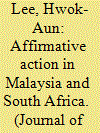

|
|
|
|
|
| Summary/Abstract |
This paper examines affirmative action in Malaysia and South Africa, two regimes that favor majorities. Malaysia’s highly centralized and discretionary programme is in contrasts with South Africa’s more democratized, decentralized and statutory structure. With regard to affirmative action outcomes, both countries have made quantitative gains in increasing representation of Bumiputeras in Malaysia and blacks in South Africa, in tertiary education and high-level occupations. However, there is also evidence to suggest continuing, primarily qualitative, shortfalls, in terms of graduate capability, dependence on public sector employment, and persistent difficulty in cultivating private enterprise. The results reported here emphasize the importance of implementing affirmative action effectively in education, while exercising restraint in employment and enterprise development.
|
|
|
|
|
|
|
|
|
|
|
|
|
|
|
|
| 2 |
ID:
148242
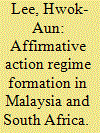

|
|
|
|
|
| Summary/Abstract |
This paper examines the formation of majority-favouring affirmative action (AA) regimes in Malaysia and South Africa. Malaysia’s Constitution premises AA on a group’s special position; South Africa’s refers to unfair discrimination. Malaysia established AA amid continuation of a political order and consolidation of executive power, while South Africa democratized and transitioned from minority to majority rule. Minority groups held less economic power in Malaysia than in South Africa. Consequently, AA in Malaysia is characterized by discretionary decision-making, and quota-based, centralized programmes, whereas South Africa has followed a legislative route involving negotiation and enforcement of target-based, statutory requirements, under less centralized oversight.
|
|
|
|
|
|
|
|
|
|
|
|
|
|
|
|
| 3 |
ID:
170130
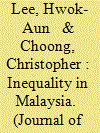

|
|
|
|
|
| Summary/Abstract |
Malaysia has consistently placed high priority on reducing income inequality, particularly between ethnic groups, with increasing emphasis in recent years on national—rather than intergroup—inequality, exclusion of low-income households, and gender disparity. Official statistics show steeply declining household income inequality in recent years, and a marginal gender wage gap, but further investigation finds different trends and more nuanced pictures. This paper presents alternative findings that pose questions about the official account. Computing estimates of wage distribution, the study finds moderate changes in inequality, with relatively higher wage growth at the top and bottom ends—managers, production and elementary workers—while professionals, skilled workers and service workers have experienced slower gains. Shifts in Malaysia's economic structure and labour markets are consistent with the modest changes in inequality that are observed, and somewhat confound the drastic drop plotted in official sources. On gender inequality, women's rapidly increased educational attainment and steadily rising labour participation have bolstered their economic standing, and may account for the surprisingly low average male-female wage disparity. However, when disaggregated by occupation, age group, and employment status, substantial gender gaps are observed. Malaysia's efforts to redress inequality warrant more rigorous analyses and systematic policies.
|
|
|
|
|
|
|
|
|
|
|
|
|
|
|
|
| 4 |
ID:
170127
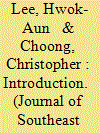

|
|
|
| 5 |
ID:
156969
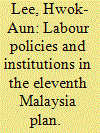

|
|
|
|
|
| Summary/Abstract |
This paper examines the progress and shortfalls in Malaysia’s labour markets and institutions, and the policies proposed in the Eleventh Malaysia Plan (11MP). While the economy has steadily grown, labour market institutions and policies distinctly lag behind the standards, productivity levels and regulatory efficacy of advanced economies. Commitments to promote productivity and wage growth, boost employment especially for women and young workers, enhance labour market information and improve foreign labour management are welcome. Nonetheless, the 11MP insufficiently confronts labour market structures that perpetuate insecure, indirect and transient employment and overwork, impeding overall productivity gains and prolonging dependency on low-skilled migrant labour. Higher goals and deeper shifts are needed not only to increase productivity and wages per hour as the driving purpose, but also to institute laws and policies overseeing fairness, equality, discrimination, worker representation, social protection and gainful part-time employment.
|
|
|
|
|
|
|
|
|
|
|
|
|
|
|
|
|
|
|
|
|